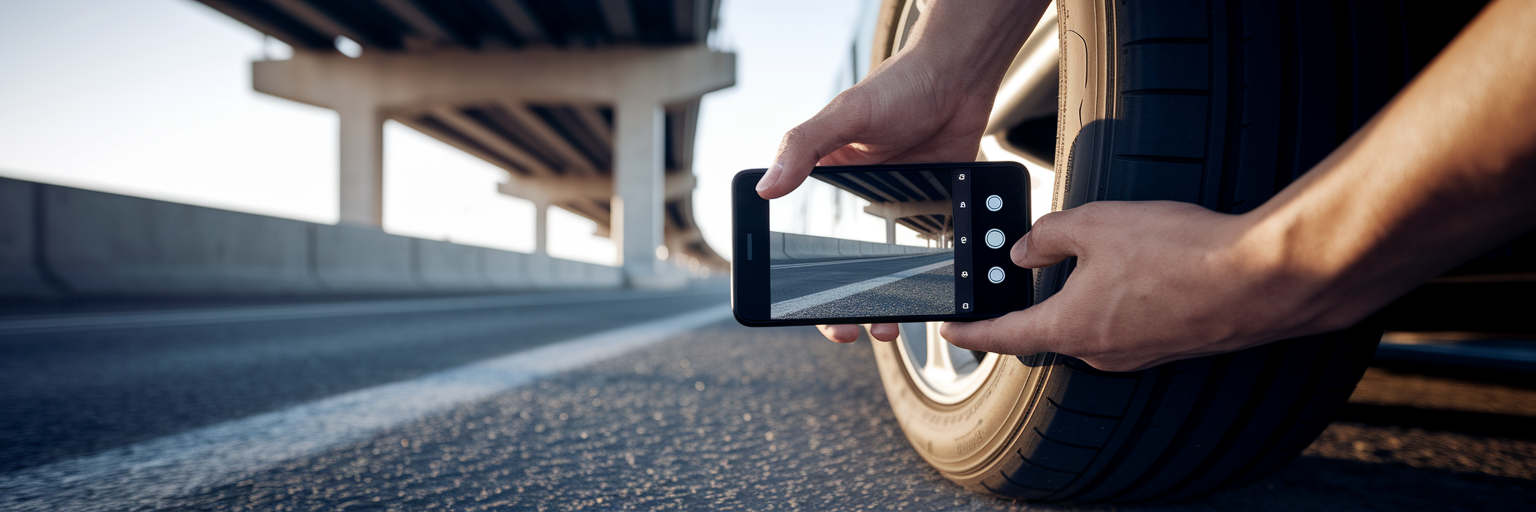The Downtown Connector in Atlanta is not just a stretch of highway; it's a central artery where I-75 and I-85 merge, carrying hundreds of thousands of vehicles daily. The sheer volume and speed mean that a moment of distraction can lead to a serious collision. Knowing what to do in the immediate aftermath is critical for your safety and the strength of any future claim.
Immediate Steps After a Crash on I-75/I-85
In the chaotic moments following a crash on the Connector, your first priority is safety. The risk of secondary collisions is extremely high with traffic continuing to move at high speeds. The actions you take here form the essential foundation for a successful I-75 accident claim. Follow these steps methodically:
- Assess for Injuries. Check on yourself and your passengers first. If anyone is seriously injured, do not move them unless they are in immediate danger from fire or traffic.
- Move to a Safe Location. If your vehicle is drivable and you are not seriously hurt, move it to the nearest shoulder. Remaining in a live lane of traffic on the Connector is incredibly dangerous. If you cannot move your car, turn on your hazard lights immediately.
- Call 911. Report the accident to the police. This is crucial. It ensures medical help is dispatched and that an officer will create an official report, which is a vital piece of evidence.
- Alert Other Drivers. Use your hazard lights to make your vehicle as visible as possible. If you have flares or reflective triangles, use them if it is safe to do so.
These initial actions are about securing the scene and getting official help on the way. Only after you are safe should you begin to think about gathering evidence.
Gathering Critical Evidence at the Scene

Once you are out of harm's way and have contacted emergency services, the evidence you collect can significantly impact the outcome of your claim. Memories fade and vehicles are cleared away quickly, so what you document in these moments is invaluable, especially in a potential multi-vehicle accident Georgia is known for on its interstates.
Focus on capturing the following details:
- Photographs and Videos. Use your phone to take pictures of everything. Capture the damage to all vehicles involved, their positions on the road, skid marks, and any relevant road signs or landmarks. A wide shot of the entire scene helps establish context.
- Information from Others. Exchange names, phone numbers, addresses, driver's license numbers, and insurance information with all other drivers. If there are witnesses, get their names and contact details. An independent witness can be a powerful asset for your claim.
- Police Report Details. Ask the responding officer for their name, badge number, and the police report number. This report will contain the officer's initial assessment of the incident.
- Personal Notes. Write down everything you remember about how the crash happened while it's still fresh in your mind. Note the time, weather conditions, and traffic flow.
This documentation is the first step in a complex process. Having a reliable source of information is key, and many drivers find it helpful to consult with legal professionals who serve the Atlanta area for initial guidance.
Understanding Georgia's At-Fault Insurance System
With evidence gathered, you will enter the insurance claims process, which operates under specific Georgia car accident laws. Unlike some states, Georgia uses an "at-fault" system, which directly influences how compensation is paid after a Downtown Connector accident. Understanding these rules is essential for protecting your rights.
Georgia's "At-Fault" System Explained
In simple terms, the person or party who caused the accident is responsible for paying for the damages. This is why proving fault is the central challenge in any I-85 crash claim Atlanta. The evidence you collected at the scene, along with the police report and witness statements, will be used by insurance companies to determine who was negligent.
How Comparative Negligence Works in Multi-Car Pileups
Fault is not always a 100% or 0% issue. In a multi-car pileup on the Connector, several drivers might share a portion of the blame. Georgia follows a "modified comparative negligence" rule. This means you can still recover damages as long as you are less than 50% at fault. However, your compensation will be reduced by your percentage of fault. If you are found 20% responsible, your final settlement is reduced by 20%. If you are deemed 50% or more at fault, you cannot recover any compensation at all.
State Minimum Insurance vs. Recommended Coverage
The law requires drivers to carry minimum liability insurance, but these amounts are often insufficient for a serious highway crash. The costs of medical treatment and vehicle repairs for modern cars can quickly exceed these low limits, leaving you with significant out-of-pocket expenses.
| Coverage Type | Georgia State Minimum | Recommended Coverage | Why It Matters for a Connector Crash |
|---|---|---|---|
| Bodily Injury Liability (per person) | $25,000 | $100,000+ | Covers severe injuries, which are common in high-speed highway accidents. |
| Bodily Injury Liability (per accident) | $50,000 | $300,000+ | Protects you in multi-vehicle accidents with multiple injured parties. |
| Property Damage Liability | $25,000 | $100,000+ | Covers the cost of modern vehicles, which can easily exceed the state minimum. |
| Uninsured/Underinsured Motorist (UM/UIM) | Not Required | $100,000/$300,000 | Pays for your damages if the at-fault driver has no insurance or not enough. |
Critical Filing Deadlines for Your Claim

Beyond the rules of fault, you must also adhere to strict legal timelines. Georgia's statute of limitations sets a firm deadline for filing a lawsuit. Missing this window means you forfeit your right to seek compensation through the court system, no matter how strong your case is. This is a detail that insurance adjusters are keenly aware of.
For most car accidents in Georgia, the deadlines are:
- Two years from the date of the accident to file a lawsuit for personal injuries.
- Four years from the date of the accident to file a lawsuit for property damage.
It is important to understand the difference between an insurance claim and a lawsuit. You should notify your insurance company of the accident almost immediately. The legal deadlines, however, apply to the formal act of filing a lawsuit in court. While two years may seem like a long time, building a strong case, negotiating with insurers, and preparing legal documents takes time. Waiting too long can seriously jeopardize your claim.
Why Legal Help Is Essential for Connector Crashes
The combination of a chaotic crash scene, complex fault determinations, and unyielding legal deadlines can make handling a Downtown Connector accident claim feel impossible. This is where professional legal help becomes invaluable. An experienced attorney can manage the process, allowing you to focus on your recovery.
An Atlanta car accident lawyer Downtown provides critical support by:
- Conducting a Thorough Investigation. They go beyond the initial police report, gathering evidence, interviewing witnesses, and, if necessary, hiring accident reconstruction experts to prove fault in a complicated pileup.
- Managing All Insurance Communications. They handle all discussions with insurance adjusters, protecting you from tactics designed to devalue your claim or get you to admit partial fault.
- Calculating the True Value of Your Claim. An experienced Atlanta car accident lawyer understands the tactics insurers use and will fight to maximize your compensation, covering everything from current and future medical bills to lost wages and pain and suffering.
- Ensuring All Deadlines Are Met. They manage the legal calendar meticulously, ensuring all paperwork is filed correctly and on time, preserving your right to justice.
They leverage their knowledge of past cases and successful outcomes to build the strongest case possible on your behalf. If you are feeling overwhelmed after a crash on the Connector, do not hesitate to seek guidance. You can reach out for a free consultation to understand your rights and options.

